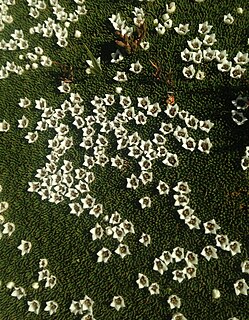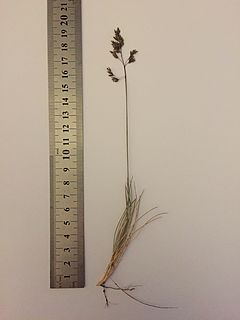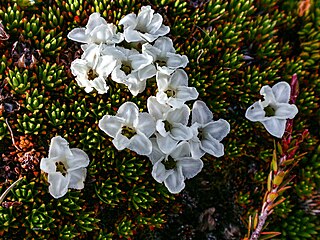
Archeria is a small genus of shrubs in the family Ericaceae. As currently circumscribed the group includes six species, all native to southern Australasia. Four of these are endemic to Tasmania, and the other two endemic to New Zealand.

Gahnia grandis is a tussock-forming perennial plant found in southeastern mainland Australia and Tasmania.

Azorella macquariensis, also known as Macquarie azorella or Macquarie cushions, is a species of cushion plant endemic to Australia’s subantarctic Macquarie Island. It was referred to the more widely distributed Azorella selago until 1989, when it was described as a separate species.

Persoonia muelleri, commonly known as Mueller’s geebung, is a shrub endemic to Tasmania. It forms a shrub in open areas of wet forests in the west and northeast of the state. It is occasionally confused with P. gunnii though it has larger flowers and longer, straighter leaves.

Pomaderris apetala is a small tree or large shrub from the family Rhamnaceae, growing in Victoria, New Zealand and Tasmania. Two subspecies have been recognised:

Eucalyptus pulchella, commonly known as the white peppermint or narrow-leaved peppermint, is a species of small to medium-sized tree that is endemic to Tasmania. it has smooth bark, sometimes with rough fibrous bark on older trees, linear leaves, flower buds in groups of nine to twenty or more, white flowers and cup-shaped to shortened spherical fruit.

Tasmanian cushion plants are low growing, highly compact, woody, spreading mats that can grow up to 3 m in diameter, located mainly on the island of Tasmania. These mats are made up of tightly packed stems that grow at the same rate so that no apical rosettes protrude above the rest. The term cushion plant refers to a characteristic growth habit adopted by various species from a range of families in order to adapt to alpine and subalpine environments and areas of high latitude. They are adapted to grow in low nutrient areas and typically have deep taproots. Cushion plants are very slow growing and do not grow high above ground; mounds typically remain under 30 cm high. Underneath the living surface of the cushion, the plants either allow dead leaves to persist or produce non-photosynthetic material, resulting in an insulating effect.

Campynema is a genus in the family Campynemataceae first described in 1805. It contains only one known species (monotypic), Campynema lineare, endemic to the island of Tasmania in Australia. Its closest relative is Campynemanthe, endemic to New Caledonia, sole other genus of the family.

Astelia alpina called pineapple grass, silver astelia, or perching lily is a commonly found species in alpine and subalpine areas of Tasmania and the Australian Alps. It is a perennial herb that typically dominates its environment by growing in dense clusters, called mats, in alpine bogs. There are two subspecies: Astelia alpina var. novae hollandiae from New South Wales and Victoria and Astelia alpina var. alpina endemic to Tasmania. Both subspecies appear very similar to each other. The species was originally described by Robert Brown.

Poa gunnii is a Tasmanian endemic tussock grass considered one of the most abundant and common in alpine and subalpine environments from about 800 m to above 1400 m. However it can be found to near sea level in the south of the island state where a cooler climate is prevalent. The genus Poa belongs to the family Poaceae. Tasmania has 16 native and 6 introduced species of Poa.
Wahlenbergia saxicola, commonly known as the rock bluebell, is a herbaceous plant in the family Campanulaceae native to Tasmania in Australia.

Arthrochilus huntianus, commonly known as common elbow orchid, is a flowering plant in the orchid family (Orchidaceae) and is endemic to south-eastern Australia. It has no leaves but an insect-like flower which has its labellum dangling like a lure away from the rest of the flower. Because of its thin, wiry stem and small, dull-coloured flowers, this orchid is difficult to locate. Like others in the genus, the flowers are pollinated by a species of thynnid wasp. Some authorities use the name Thynninorchis huntiana for this orchid.

Actinotus moorei, the splitleaf flannelflower, is an endemic Tasmanian perennial herb in the family Apiaceae. It is found in wet ground at high elevation in Tasmania's Central Plateau as well as western and south-western mountains.

Actinotus suffocatus, the crimson flannelflower, is a small, perennial herb endemic to the Australian State of Tasmania. It is primarily found in high-elevation habitats in wet situations, except in the far south-west of the island, where it occurs down to sea level in continually moist habitats.

Cryptostylis leptochila, commonly known as the small tongue orchid, is a species of orchid that is endemic to eastern Australia. It has one to a few broad leaves and up to fifteen green flowers with a dark red labellum that has a black stripe and rows of black dots either side of the stripe. As with others in the genus, it is pollinated by male ichneumon wasps.

Xyris marginata, commonly known as alpine yellow eye, was first collected by German-Australian botanist Ferdinand von Mueller in 1875. Xyris marginata is a monocot in the family Xyridaceae which is endemic to King Island (Tasmania) and Tasmania, commonly growing in button grass moorlands, at altitudes of up to 1070 meters (3,510.5 ft) above sea level.

Chionogentias diemensis is a flowering herbaceous alpine plant in the family Gentianaceae, endemic to the island of Tasmania in Australia. It is commonly known as the Tasmanian mountain gentian. Chionogentias diemensis has been classified into two sub-species: the Tasmanian snow-gentian and the Ben Lomond snow-gentian.

Swainsona procumbens is a plant in the pea family (Fabaceae) native to Australia and found in New South Wales, Victoria, Queensland and South Australia.

Ptilotus schwartzii is a grass-like plant in the Amaranthaceae family.

Dracophyllum minimum, commonly known as Heath Cushionplant or Claspleaf heath, is a species of bolster cushion plant endemic to Tasmania, Australia.. It is a low growing, highly compacted plant with white flowers, commonly found in alpine areas of the south, centre and west of Tasmania.




















